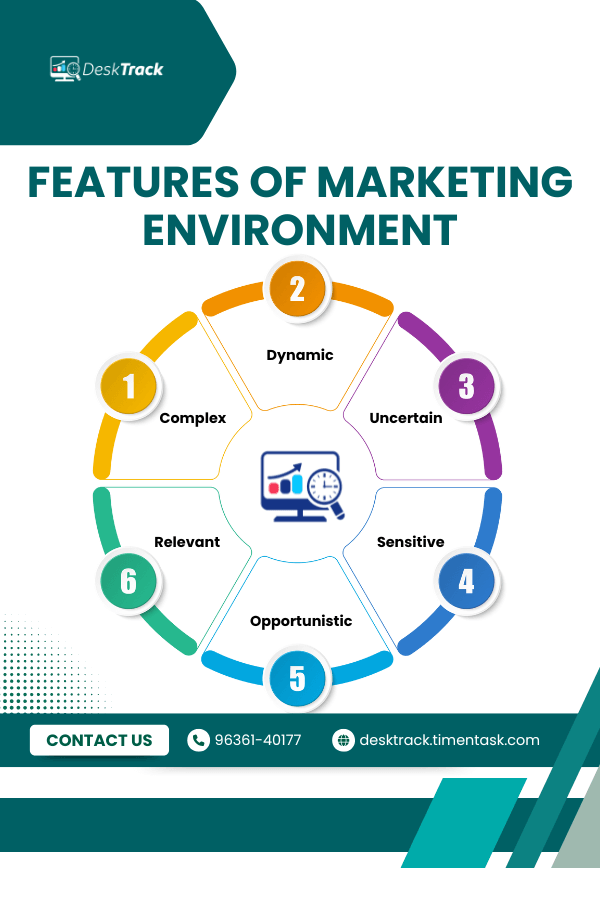
Your products or services are as good as old books eating dust in the storeroom unless you market them right. The first step to marketing your products and services to the right consumer base is understanding the marketing environment around your industry.
What is a Marketing Environment?
The marketing environment for your business and industry includes everything and everyone that directly or indirectly affects your marketing strategies, operations, and decision-making. You can control some of these factors, such as your employees and resources, according to your requirements and plan. However, for other influences, such as natural disasters, you are the one to compromise and adjust.
Read Also: How to Calculate Employee Hours Worked? Minus the Frustration
Features of Marketing Environment

The ever-changing environment of marketing for businesses is backed by several characteristics. Interestingly, all of these factors affect how you market your products and services to consumers.
1. Complex
In short, it’s unpredictable. Every component in the atmosphere is interrelated and interdependent. Even a slight change in one aspect will affect the others. On top of that, the change is situational, making it even harder to understand.
2. Dynamic
As we mentioned before, the environment in marketing is ever-changing. Take natural disasters, for example. One earthquake will influence how you operate, your business’s form, and character.
3. Relevant
As we mentioned before, the environment and marketing are correlated. The atmosphere affects your decisions, and thus, correctly understanding and accounting for all its elements is crucial for the success of all your marketing campaigns.
4. Uncertain
Here’s the universal truth. All marketers must continuously research to cope with the unpredictable nature of the marketing environment in marketing management. Anything can change without notice, and thus, you must be prepared to adjust and scale your strategies accordingly.
5. Opportunistic
In short, you need to have a solution to fulfill every new demand. Contrary to its uncertainty, the atmosphere in marketing brings many opportunities for you to tap into what’s new. The idea here is that if you mold your marketing strategies according to every change, you can gain a brand new market. However, you must prepare for it in advance and try to align everything according to the demand.
6. Sensitive
The marketing atmosphere is sensitive to various external and internal factors that are never stable. Mostly external. For example, if the interest of the consumer suddenly declines in, let’s say, nutty chocolate, then its demand will also decrease. Just like that. In these situations, all businesses manufacturing this product will be affected. However, this sensitiveness can be positive for businesses as well. For example, if an earthquake results in grave loss, you can capitalize on it by supporting the aid in your campaign.
Types of Marketing Environment
Make your workday more productive
Time tracking and work management can help you reach your goals
faster.
Similar to how many factors affect it, there are also 3 types of marketing environments you need to wrap your head around. As we mentioned before, these directly and indirectly affect your campaign strategies.
1. Internal
This is where you have the most control. The internal environment is closest to your business. Simply put, it’s everything and everyone that operates within your organization’s boundaries. For instance:
- Staff members – management, finance, research and development, purchasing, business operations, accounting
- Internal assets
- Business policy
- Logistics
- Inventory
2. Micro
The first external environment in marketing would be the micro atmosphere, which is related to your daily work. Here, you still have control in some areas as the included elements are adjacent to your business. For example:
- Customers – consumer market, international market, B2B
- Competitors
- Suppliers
- Distributors
- Shareholders or strategic partners – intermediaries, agencies, accountants
- Publics – interest groups, environmental groups, the media
3. Macro
The last external environment is macro. Here, you can forget about having any control. However, these factors are in charge of how your marketing strategies will change. However, these can still be analyzed with the PESTELE method, where PESTELE expands to:
- Social/Cultural: Demographics, population growth or decline, age distribution, education, cultural differences, lifestyle trends, health and welfare, career attitudes
- Technological: Innovation, big data, IoT, automation, research, tech awareness, technological growth, skilled resources, smartphones, advanced AI, tracking, location data
- Economic: National and international economic growth or decline, exchange rates, interest rates, inflation, purchasing power, employment rates, income, investment, opportunities
- Ethical: Bribery, intellectual property, reputation, business, ethics or morals, confidentiality, privacy
- Political: Government policy, taxation, political stability, foreign trade, trade restrictions
- Legal: Court system, employment law, discrimination law, anti-trust law, trade unions, consumer protection, health and safety, copyright law, GDPR
- Environmental: Weather, climate change, emissions, environmental policies, pressure from NGOs, natural disasters
Factors Affecting Your Business’s Marketing Environment

Many internal and external things affect the atmosphere around your marketing campaigns and strategies. Before understanding these, remember that there will be no control over these influences. Plus, you must adjust your campaigns, even multiple times, to adapt to these changes.
1. Socio-Cultural
Especially for international businesses, understanding the social and cultural factors of the local market you are targeting is crucial. However, here you can’t go overboard, as it can badly affect consumer sentiments and throw you out of the market instead.
2. Economic
The economic factors within your organization and in the market you are planning to capture gradually affect your strategy. The idea is to have the perfect budget for everything. This includes things such as inflation rates, which have an impact on the investments you and your clients make.
3. Technological
Technological influences are all about the ever-changing market. This factor is rapid, as the new generation of consumers always has new demands. Another thing it does is also force you to train your employees to use the latest technology to market your products and services to a broader customer base through the latest channels.
4. International
The next factor influencing the marketing environment for your business is the international policies and demands. What we are talking about here is that when you are marketing your product at a global level, you need to be updated with the international trade policies and public demand for continued success.
5. Demographic
The idea here is to know everything about who you are selling your product to. You need every specific detail, including what they prefer, what they don’t, their sentiments, and adapt your strategies accordingly.
6. Political & Legal
In short, you can’t do everything possible to market your products and services. There are some legal restrictions and political boundaries that you don’t want to cross. Even by mistake. A simple example would be banned products and services or tax regulations.
7. Ecological
Other than your products and services being environmentally friendly, your marketing campaigns must also be green and safe to Mother Earth. For example, producing no carbon footprint or growing a tree for every paper poster you print. Customers these days are also interested in knowing these things about you. Just saying.
Benefits of Understanding Your Business’s Marketing Environment

Now, we are done with the first question. What is the environment in marketing? However, now we need to know why we need to understand it.
1. Helps Build Strategic Plans
When you wrap your head around what’s trending in your target market, planning strategically around it becomes simpler. When you have the right details, you can target a solution perfectly for the biggest pain point troubling your customers in the current scenario.
2. Simplifies Opportunity Identification
Knowing all about the current market demands and where your competition stands in fulfilling these demands makes it simple for you to identify opportunities. More importantly, understanding the situation around your marketing environment boosts your opportunity to grab your chance at success.
3. Helps Conduct Competitor Analysis
Remember that you are not the only one who can provide a solution to or a product that can solve the problem. Similar businesses are also doing it, and so you need to provide a better solution. Understanding your marketing environment provides you with an edge in evaluating where your competitors lack and makes a better campaign than they do.
4. Helps Avoid Risks
Factors, including inflation rates, improvised laws, taxation policies, and changing consumer sentiments, are all risks you need to watch out for. Understanding your ever-changing marketing environment lets you know the specifics and market your products without crossing boundaries.
5. Provides Customer Insights
Marketing environmental insights also include customer insights, such as what customers like, their sentiments, their demographics, total population, purchasing power, and much more. For example, if you identify the products preferred by people of a specific region, tailoring your marketing campaign for that location to include that specific product becomes much easier.
6. Streamlines Resource Allocation
When you understand your internal environment in marketing, you realize the amount of resources your teams require to get the job done right. Then, you can easily allocate them, ensuring that the right skills and tools are mapped with the right projects and tasks.
7. Simplifies Adaptation
The market is never stable. Demands keep changing, tax rates vary, and inflation is always unpredictable. Staying updated with the current marketing trends makes it much simpler for you to adapt and achieve success.
Read Also: The Complete Guide to ERP Implementation
Challenges in the Business Marketing Environment
Understanding the business marketing environment is never smooth sailing. There are a few challenges that you also need to overcome.
1. Unpredictable & Complex
As we have mentioned several times, the market is always unpredictable and complex. A campaign going well can crash in the middle due to a sudden change in let’s say, in the weather or an unexpected decline in the demand for the product you are promoting.
2. Demanding Resources
The demand for resources in the internal environment of marketing in your business is always changing. Keeping up with that can be hard, unless you are using the right project management software.
3. Information Overload
There’s a lot of information about consumers in the widespread market. For a successful campaign, you need to filter only your industry-relevant chunks from this large volume of information. Although the results are rewarding, the process itself is time-consuming and frustrating.
4. Misinterpretation Risk
This is the most common challenge in the environment and marketing. For example, misinterpreting consumer sentiments and making a stereotyped marketing campaign out of it is very common.
5. Pressure from the Competition
As we mentioned above, you are not the only one providing solutions to or products that can solve the consumers’ problems. If you let your competition get ahead, there will be pressure from them to provide better solutions or show that your product is better, even if it’s not. This can be a roadblock in a rather smooth campaign.
6. Environmental & Ethical Considerations
As we mentioned before, you cannot do everything possible to market your products and services. There are also environmental and ethical considerations. For example, staying away from negative or black hat marketing practices.
Monitor Your Internal Marketing Environment with DeskTrack & Maximize Productivity
As you now know, you have little or no control over the external marketing environments. However, you are in charge of your organization’s marketing employees, teams, and other resources. However, when monitoring them, you need to be extremely careful not to micromanage and cross ethical or employee monitoring boundaries. The idea is to only analyze crucial, useful insights, and DeskTrack’s employee monitoring software provides you with just that. That is, real-time insights that actually prove why a project was delayed. Monitor your internal marketing environment and campaign processes with DeskTrack and realize how it has helped maximize business productivity across 100+ countries.
Frequently Asked Questions (FAQ)
Q. What is the Marketing Environment?
Ans. The marketing environment for your business and industry includes everything and everyone that directly or indirectly affects your marketing strategies, operations, and decision-making.
Q. What are the 5 Main Characteristics of a Marketing Environment?
Ans. Your marketing atmosphere is defined by:
- Customer orientation
- Consumer satisfaction
- Market research
- Market planning
- Integrated marketing
Q. What are the 7 Factors Affecting the Marketing Environment?
Ans. These aspects influence the marketing atmosphere.
- Socio-Cultural
- Economic
- Technological
- International
- Demographic
- Political & Legal
- Ecological
Q. What are the Types of Market Environments?
Ans. These are the 3 types of environment in marketing.
- Internal
- Micro
- Macro
Q. What are the Challenges in the Business Marketing Environment?
Ans. Understanding the business marketing environment is never smooth sailing. There are a few challenges that you also need to overcome.
- Unpredictable & Complex
- Demanding Resources
- Information Overload
- Misinterpretation Risk
- Pressure from the Competition
- Environmental & Ethical Considerations










